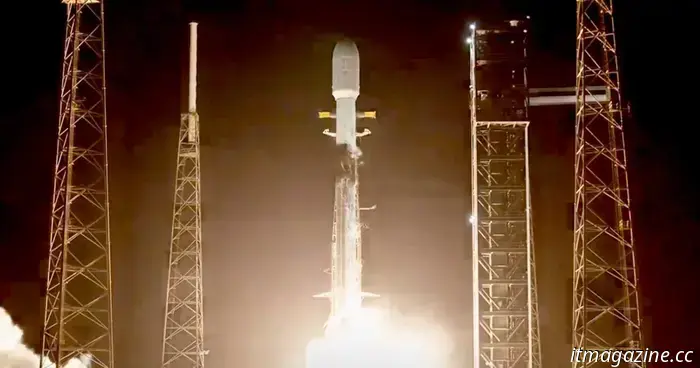
A SpaceX Falcon 9 rocket has recently established a new record.
After a mission early on Monday, the first stage of a SpaceX Falcon 9 rocket made history by becoming the first to launch and land 27 times.
The Falcon 9 lifted off from Cape Canaveral in Florida at midnight on April 14, successfully deploying 27 Starlink satellites into low-Earth orbit.
Below is a clip of the record-setting rocket launching on its 27th mission:
To facilitate the reuse of the first stage, SpaceX has created a system that returns the booster by landing it vertically, either on land or on a barge — referred to by SpaceX as a “droneship” — situated off the coast of Florida. In the mission on Monday, the rocket landed on the Just Read the Instructions droneship approximately eight minutes after liftoff. The video below captures the safe landing, setting the stage for the booster’s 28th flight.
This specific first-stage booster had previously launched missions including CRS-22, Crew-3, Turksat 5B, Crew-4, CRS-25, Eutelsat HOTBIRD 13G, O3B mPOWER-A, PSN SATRIA, Telkomsat Merah Putih 2, Galileo L13, Koreasat-6A, and now 16 Starlink missions.
Before Monday's mission, the B1067 booster last took flight on February 15, when it also delivered a group of Starlink satellites to low-Earth orbit.
The reuse of the rocket’s first stage has allowed SpaceX to significantly reduce launch costs, making space access more affordable for a larger number of commercial enterprises, government agencies, and research institutions eager to deploy satellites.
After several unsuccessful attempts, SpaceX achieved its first Falcon 9 booster landing in 2015, and since then, the team has perfected the technique.
SpaceX engineers have leveraged their experiences to enhance the next-generation Starship rocket, whose first-stage booster, the 71-meter-tall Super Heavy, descends into the grasp of the launch tower's massive mechanical arms upon returning to Earth. If you haven't seen it before, this remarkable maneuver is certainly worth a watch.
SpaceX envisions that with ongoing advancements, Starship flights utilizing the same Super Heavy booster could occur within just a few days once inspections and refurbishments are completed.
Once operational, the Starship is anticipated to transport crew and cargo to the moon as part of NASA's Artemis program, as well as undertake the first crewed mission to Mars, potentially in the 2030s.
Other articles
 The 70th birthday of the astronaut will feature a roller coaster ride in space.
NASA's Don Pettit is preparing for an exciting journey this weekend.
The 70th birthday of the astronaut will feature a roller coaster ride in space.
NASA's Don Pettit is preparing for an exciting journey this weekend.
 Honor is leveraging AI to enhance your smartphone photos, making them not only better but also larger.
Honor has recently introduced several updates related to AI that will be integrated into its smartphones, featuring a new photo editing tool known as AI outpainting.
Honor is leveraging AI to enhance your smartphone photos, making them not only better but also larger.
Honor has recently introduced several updates related to AI that will be integrated into its smartphones, featuring a new photo editing tool known as AI outpainting.
 OnePlus' upcoming phone is a small yet powerful device, and it will be released shortly.
After the introduction of the OnePlus 13 in January, the next device we can expect from the well-known subsidiary of Oppo is the OnePlus 13T. The official unveiling of this phone is scheduled for April 24, so we won't have to wait much longer. However, there is a small twist: the launch is taking […]
OnePlus' upcoming phone is a small yet powerful device, and it will be released shortly.
After the introduction of the OnePlus 13 in January, the next device we can expect from the well-known subsidiary of Oppo is the OnePlus 13T. The official unveiling of this phone is scheduled for April 24, so we won't have to wait much longer. However, there is a small twist: the launch is taking […]
 Electric vehicles surpass gasoline cars in German reliability report — yet one persistent weakness remains.
According to Germany’s ADAC, which is Europe’s largest roadside assistance provider, electric vehicles (EVs) are now more dependable than vehicles with internal combustion engines (ICE).
Electric vehicles surpass gasoline cars in German reliability report — yet one persistent weakness remains.
According to Germany’s ADAC, which is Europe’s largest roadside assistance provider, electric vehicles (EVs) are now more dependable than vehicles with internal combustion engines (ICE).
 Begin your drawing journey today: receive your 7-day free trial of Simply Draw.
Have you ever wanted to learn how to draw, but felt daunted by where to start? It might be the empty canvas or that inner voice telling you that you can't even draw a straight line. You're not the only one feeling this way. A guided drawing app from the creators of Simply Piano and Simply Guitar has been developed to […]
Begin your drawing journey today: receive your 7-day free trial of Simply Draw.
Have you ever wanted to learn how to draw, but felt daunted by where to start? It might be the empty canvas or that inner voice telling you that you can't even draw a straight line. You're not the only one feeling this way. A guided drawing app from the creators of Simply Piano and Simply Guitar has been developed to […]
 Apple is counting on your emails to resolve issues with its malfunctioning AI.
Apple will match artificial sentences with the content of your emails in order to improve its AI. The company assures that users' emails will never leave their iPhone or Mac.
Apple is counting on your emails to resolve issues with its malfunctioning AI.
Apple will match artificial sentences with the content of your emails in order to improve its AI. The company assures that users' emails will never leave their iPhone or Mac.
A SpaceX Falcon 9 rocket has recently established a new record.
SpaceX has achieved a new milestone with one of its reliable Falcon 9 boosters.
